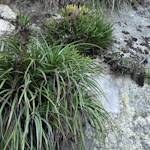Tennessee purple coneflower
1979 CE • Tennessee
"Tennessee purple coneflower, like other coneflowers, has beautiful daisy-shaped flowers, is a butterfly magnet, and thrives in hot, dry, sunny weather. Unlike most coneflowers, it spent 32 years on the US Fish and Wildlife Service’s Endangered Species list. Because of conservation efforts, in 2011 it was removed from this list. Echinacea tennesseensis is endemic to a specific habitat within a 14-mile radius covering three counties in the Nashville, Tennessee area. This habitat, called a limestone cedar glade, develops in red cedar forests where limestone bedrock close to the surface renders the soil too shallow for woody tree roots. This creates openings, or glades, in the forest, similar to wide open prairies. These areas tend to be wetter in the winter and spring, then quite dry throughout the summer. This coneflower was able to thrive in that area because its tap root could work its way down through fissures in the limestone to access deeply-seated moisture. However, the rapid expansion and development of the Nashville area and its suburbs in the mid to late twentieth century became an immediate threat to this habitat and the Tennessee coneflower. After being added to the Endangered Species list in 1979, only the second plant to be added, public and private, and state and federal entities, created and implemented a conservation plan where the existing coneflower populations were supplemented and protected, and the threats were neutralized."
Sonya Anderson, "A conservation success story: Tennessee purple coneflower," Plant Select.
Image: BlueRidgeKittie via Flickr, CC BY-NC-SA 2.0 DEED, Attribution-NonCommercial-ShareAlike 2.0 Generic


Learn about Maya Lin’s fifth and final memorial: a multi-platform science based artwork that presents an ecological history of our world - past, present, and future.

Discover ecological histories and stories of former abundance, loss, and recovery on the map of memory.

Learn how we can reduce our emissions and protect and restore species and habitats – around the world.

See how art can help us rethink the problems we face, and give us hope that each one of us can make a difference.

Help make a global memorial something personal and close to home. Share your stories of the natural world.


